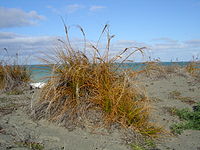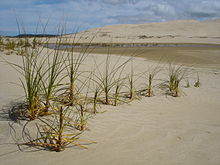- Pingao
-
Pingao Pingao on Kaitorete Spit in Canterbury. Scientific classification Kingdom: Plantae (unranked): Angiosperms (unranked): Monocots (unranked): Commelinids Order: Poales Family: Cyperaceae Genus: Ficinia Species: F. spiralis Binomial name Ficinia spiralis
(A.RIch) Muasya & de LangeSynonyms[1] - Isolepis spiralis A.Rich.
- Desmoschoenus spiralis (A.Rich.) Hook.f.
- Anthophyllum urvillei Steudel
- Scirpus frondosus Boeck
- Scirpus spiralis (A.Rich.) Druce
Pingao, Ficinia spiralis, also known as golden sand sedge is a coastal sedge endemic to New Zealand (including the Chatham Islands). Originally widespread, it has suffered severely from competition with introduced marram grass and animal grazing and now has only a patchy distribution.
Leaves from this plant are used by Maori in weaving. The leaves turn a bright yellow as they dry. Pīngao is a stout, grass-like plant, 30–90 cm tall, from the sedge family, found on active sand dunes. It is found only in New Zealand and is easily distinguished from other species that grow on sand dunes.
Most plants produce long, prostrate, tough rope-like stems (rhizomes) that creep along the sand surface until buried by shifting sand, leaving just the upper portion of leaves exposed. Some southern South Island populations produce dense tussock-like plants without extensive rhizomes.
Numerous tough, roughly textured leaves are borne in dense tufts on well-spaced, short, upright stems (tillers), along the length of rhizomes. The narrow leaves are 2–5 mm wide, with colour ranging from green through yellow to orange. Seen from a distance, pīngao patches have a distinctive orange hue. The length, width and strength of the leaves for weaving vary among pīngao populations growing in different areas.
Small, dark brown flowers appear in spring and are arranged spirally in tight clusters around the upper 10–30 cm of the upright stem (culm), interspersed with leaf-like bracts. The seeds are shiny, dark brown, egg-shaped, 3–5 mm long, and ripen and fall in early summer.
The plant can multiply itself by stolons.
References
External links
- Land Care Research - pingao information
- Objects made from pingao in the collection of the Museum of New Zealand Te Papa Tongarewa
This Cyperaceae article is a stub. You can help Wikipedia by expanding it. This New Zealand plant article is a stub. You can help Wikipedia by expanding it.


